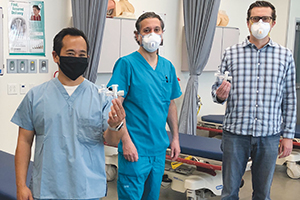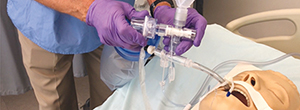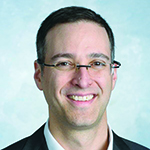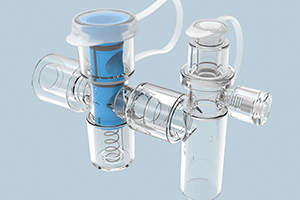By JULIE MINDA
When it became clear in early 2020 that the coronavirus could slam into the nation's health care system with the force of a tsunami, executives and staff at the La Palma, California-based Innovation Institute and at its affiliated Newport Beach, California, Innovation Lab assembled on a weekend videoconference to brainstorm about how the institute could use its expertise to help health care providers.

From left, Matthew Ibarra, Dr. Afshin Nadershahi and Ryan Kelly are shown during filming of training videos on the BayWin valve. The May 2020 filming was at Orange Coast College in Southern California. Ibarra is a design manager at the Innovation Lab; Nadershahi was executive director of clinical and market intelligence at the time; and Kelly is the lab's general manager.
The group tossed out thoughts about how to significantly speed up or adapt the development of technologies, products and ideas in the lab's pipeline that would be of most benefit to patients and clinicians during the pandemic. One product the team fast-tracked — a closed-circuit valve for use in the care of patients on ventilators — had been in development for decades and had been in a refinement process in the Innovation Lab since 2019.
Clinicians use ports in the valve to add equipment such as resuscitation bags or suction catheter systems and are able to do so without temporarily disconnecting the ventilator. (See sidebar.)
The Innovation Lab put the product development process in high gear. Within seven weeks, it had a finished product and had shipped almost 5,000 of the valves out to some of its member hospitals. Franciscan Missionaries of Our Lady Health System, Avera Health, Bon Secours Mercy Health and Providence St. Joseph Health's Covenant Health used the valve and their clinicians provided the lab with feedback about the product's efficacy.

This image from a demonstration video shows the BayWin Closed Circuit Valve in use during manual ventilation. The Innovation Lab helped to refine the valve and made it available to hospitals during the pandemic.
Through their involvement in the Innovation Lab as well as through independent efforts, these Catholic health systems and facilities have proven to be fertile ground for invention during the pandemic. (The Innovation Institute was spun off from St. Joseph Health, a legacy system of Providence, in 2013.)
"When it's routine business, everyone sticks to a routine, but when COVID hit, that routine was disrupted, and everyone's eyes were opened to being innovative," says Dr. Hollis O'Neal, a pulmonary and critical care medicine specialist at Baton Rouge, Louisiana's Our Lady of the Lake Regional Medical Center. He used the valve and gave input while it was being refined.
Care handoff
Dr. Michelle Thai is medical director for a rehabilitation program at Providence St. Jude Medical Center in Fullerton, California. About five years ago, frustrated by how difficult it was for her and other staff to locate high-quality nursing homes for patients being discharged, she began working with her son Johnathan Thai, a computer science graduate, on a solution. The duo developed Koazie, a digital platform where health care staff, patients and patients' families can search local nursing homes to see which have open beds, which have the highest quality ratings and which have the features the patient is looking for.

Thai
Thai worked with the Innovation Lab to refine the product and began rolling it out on a limited basis about two years ago. It pulls in publicly available information such as nursing homes' contact information and Medicare quality ratings. Nursing homes can pay a subscription that enables them to add additional information, such as marketing language and facility photos.
Thai says during the surge in COVID-19 in Southern California it was extremely challenging to figure out which nursing homes were admitting patients and what their admission policies were, given evolving COVID-19 protocols.
The Thais and Innovation Lab staff assigned to Koazie contacted nursing homes to ask them to add bed availability information and COVID-19 policy details to their Koazie profiles. A COVID-19 education section was added to the Koazie site for patients and families to counter confusion and misinformation that have been rampant.
Chatty Grace
Maryam Gholami is senior vice president and chief product and technology officer at Providence Digital Innovation Group. She says in mid-March 2020 Providence prioritized a COVID-19 update of a chatbot called Grace that the Digital Innovation Group had been working on since 2018.

Gholami
Providence's product development team used artificial intelligence and natural language processing to develop software with a symptom-checking feature that could answer patient questions about common, low-acuity conditions such as flu. The chatbot can connect with Providence appointment scheduling software, and — based on patients' symptoms and conditions, appointment availability and wait time — recommend care options.
These options can include virtual and in-person visits. The chatbot also can book appointments for patients. For COVID-19 specifically, Grace provides the option to choose on-demand virtual visits and lets the providers know that the patient has been pre-triaged for COVID-19 using the chatbot's assessment flow.
Gholami says the Digital Innovation Group recognized Grace's potential utility during the pandemic, when people were highly concerned about any symptoms they were experiencing, didn't know whether they should be tested for COVID-19 and were confused by conflicting information they were receiving from various outlets about the virus. Overtaxed clinicians were ill equipped to field all the incoming calls about the virus.
Working with Microsoft and other technology companies, the Digital Innovation Group spent long hours in March 2020 "teaching" Grace to field questions about COVID-19 and testing the chatbot for prime time. The team completed the retool within a week.
Since its update, the chatbot has answered questions from more than 370,000 people. Gholami notes that Grace also has supplied Providence with vital information. By analyzing Grace's millions of chat session notes with analytics software, Providence can detect patterns in what people are asking about and can in some cases predict emerging concerns. For instance, Providence was able to determine when people were growing worried about reports of serious but rare COVID-19 vaccination side effects, especially after the second dose.
Heat maps
Dr. Ari Robicsek, Providence chief medical analytics officer, said at the start of the pandemic people had a lot of questions about what they should and shouldn't do to reduce their risk of contracting COVID-19. Was it OK to visit a friend indoors? Was it safe to have an in-person socially distanced meeting?

Robicsek
Robicsek, an epidemiologist, says the answer to many such questions is contingent upon the level of viral caseload in a person's potential destination. However, he adds, the county-level maps available in the U.S. that plot viral spread are based on potentially outdated information and are too geographically broad to be of use to consumers during the pandmic.
His team devised a platform that aggregates Providence patients' COVID-19 test results and symptom notes from their clinicians mined from the electronic medical record system. It matches that information to the patients' home addresses, deidentifies the data and plots it to a heat map that uses color intensity to show a neighborhood's level of infection for a specific timeframe.
Robicsek says Providence publishes the heat maps online as a public service. He sees many potential uses for the platform for mapping other infectious diseases. He adds that Providence employed a third-party vendor to crack the deidentification privacy protection as a test of its security, and they could not.
"They say to never let a crisis go to waste, and we found this crisis was an opportunity to learn to do something we'd never done before" to benefit the community, Robicsek says. "We learned a lot about how to present data to the public at the right level and with the right level of privacy."
Vaccine passports
As the number of vaccinated individuals grew in the spring and "vaccine passports" entered the vernacular, Lumedic, a Providence company, adapted an app to create a type of vaccine wallet for patients. The Lumedic app that will soon be available to Providence patients throughout that health system's seven-state service area allows users to access their vaccination records from the Providence electronic medical record and their state's vaccine registry.
Lumedic plans to expand the app's features beyond COVID-19 vaccination verification in the future, to give patients the choice to access other medical records and information, and is expanding beyond Providence to offer it to other systems.
Closed-circuit valve protects patients and clinicians
The closed-circuit valve that the Innovation Lab and its member health systems sped to market during the pandemic has multiple benefits for care delivery. Chief among them: It enables clinicians to perform certain treatments or turn a patient without first having to disconnect the ventilator tubing and flow of oxygen.

The BayWin Closed Circuit Valve
Dr. Harry Bayron, a retired pediatric cardiologist, and Neil Winthrop, a respiratory therapist, came up with the concept for the valve, eventually partnering with the Innovation Lab to refine the design.
The BayWin Closed Circuit Valve has multiple ports that clinicians can easily open and close so that the ventilator circuit need not be broken when new devices are added or taken away during patient treatments. Some of the ports allow connection of equipment such as resuscitation bags for manual respiration.
Dr. Hollis O'Neal, a pulmonary and critical care medicine specialist at Baton Rouge, Louisiana's Our Lady of the Lake Regional Medical Center, says the device increases maneuverability when turning a ventilator patient onto their stomach to improve oxygenation. That proning procedure came to be used commonly with COVID patients.
Like O'Neal, Dr. Anthony Hericks, director of respiratory and critical care at Avera McKennan Hospital & University Health Center in Sioux Falls, South Dakota, field tested the valve and provided input on its functionality. He says there is an increased risk of pneumonia and other infections when traditional valves are disconnected — the BayWin valve aims to reduce that risk. He adds that when traditional valves, which are located near the patient's airway, are disconnected, patient respiration can become aerosolized and airborne. With a highly infectious condition like COVID, this increases the infection risk for nearby clinicians.
— JULIE MINDA